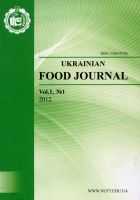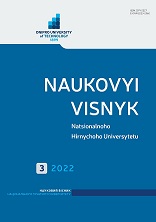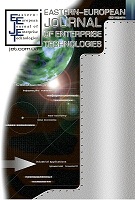
Бази даних
Наукова періодика України - результати пошуку
 |
Для швидкої роботи та реалізації всіх функціональних можливостей пошукової системи використовуйте браузер "Mozilla Firefox" |
|
|
Повнотекстовий пошук
| Знайдено в інших БД: | Реферативна база даних (11) |
Список видань за алфавітом назв: Авторський покажчик Покажчик назв публікацій  |
Пошуковий запит: (<.>A=Dunayevska N$<.>) | |||
|
Загальна кількість знайдених документів : 11 Представлено документи з 1 до 11 |
|||
| 1. | 
Dunayevska N. Thermal destruction kinetics of coal and solid biomass mixtures [Електронний ресурс] / N. Dunayevska, Y. Zasiadko, T. Shchudlo // Ukrainian food journal. - 2018. - Vol. 7, Issue 4. - С. 738-753. - Режим доступу: http://nbuv.gov.ua/UJRN/UFJ_2018_7_4_17 Проведено дослідження кінетики складових етапів процесу згоряння біомаси як індивідуально, так і у суміші з низько реакційним вугіллям антрацитової групи Донецького басейну. Зразки біомаси (включаючи відходи сільськогосподарської та харчової промисловості) та вугілля були вивчені за допомогою неізотермічної термогравіметрії. Кінетичні дослідження зразків проводилися на дериватографі системи Paulik-Paulik-Erd?je Q-1000 з інтегрованим комплексом синхронних аналізів даних STZ 449 JUPITER NETZSCH в атмосферному повітрі з швидкістю нагріву 20 <$E symbol Р>C/хв. Інтервал температур - 25 - 1000 <$E symbol Р>C. Одержані первинні дані оброблялися й узагальнювалися в рамках диференціальних та інтегральних підходів. Показано, що застосовування диференційного методу обробки даних потребує визначення поточних нормалізованих похідних від швидкості зміни маси зразку, а також балансу компонентів наважки в моменти початку та закінчення процесу, що створює серйозні труднощі. За таких умов інтегральний підхід, застосований для обробки отриманих даних, виглядає більш прийнятним. Представлено порівняння апроксимацій та узагальнення даних за різними методами. Показано, що застосування апроксимації за методом Коутса-Редферна у вигляді ряду не збільшує точності наближення при врахуванні більшої кількості членів ряду. Допустимі межі застосування методу визначаються величиною E/RT більше 4, що дійсно для процесів виходу вологи та летких. Для процесу догоряння коксового залишку слід враховувати можливі відхилення та застосовувати метод Сенума-Янга. Одержано сукупність кінетичних констант, які були використані з відповідними диференційними рівняннями типу Арреніуса для розрахунків загальної кривої термодеградації. Відхилення розрахованої поточної маси зразка від визначеної експериментально при нагріві у діапазоні 300 - 700 К не перевищує 10 %, що надає змогу рекомендувати одержані константи для інженерних розрахунків як тривалості окремих стадій процесу, так і балансів компонентів палива у процесі горіння. Висновки: методологія виділення окремих стадій процесу й отримані кінетичні константи можуть бути використані для інженерних розрахунків та у вигляді підмоделей для 3-вимірного моделювання процесів горіння твердого палива. | ||
| 2. | 
Fateyev A. I. The energy technological background of involving salty coals into energy balance of Ukraine. 1. Composition of water extracts and the prospects for their utilization [Електронний ресурс] / A. I. Fateyev, T. G. Shendrik, S. S. Polishchuk, N. I. Dunayevska // Науковий вісник Національного гірничого університету. - 2018. - № 6. - С. 40-47. - Режим доступу: http://nbuv.gov.ua/UJRN/Nvngu_2018_6_8 Coal with high content of alkaline and alkaline earth metals (salty coal (SC)) occupies its definite place in an energy reserve of Ukraine. Deposits of SC are located in central industrial regions, the coal has high fuel indexes and can soon definitely get its share in blended fuels which will meet the standards of Ukraine and will be qualified for use at modern Thermal power plant (TPPs). In order to determine the rational ways of involving salty coal in the burning processes, the world practices widely use the detailed studies of the impact of natural mineral substances on the processes of slagging, sticking and corrosion in case of the burning of such coal. Purpose. To determine the composition of natural water-soluble minerals in coal which cause a number of burning problems using non-destructive methods, a comparative analysis of the composition of mineral phases in SC from various deposits in Ukraine, to assess their slagging ability, and overview the prospects of utilizing flushing water generated during coal desalting. Methodology. Applying the technological regimes of desalting developed by the authors, water extracts of SC have been obtained, which are investigated using a non-destructive X-ray diffraction method of dry substances (device DRON 4M), the composition of mineral phases of SC extracts is studied with the MATCH! program. Total content of salts and their removal efficiency are estimated using the 4805 Conductivity TDS/Temp indicator/EZODO. Findings. The composition and peculiarities of the mineral phases from extracts of salty coals of different domestic deposits are determined. The fouling factor of SCs of different deposits in Ukraine was calculated from the chemical composition of ash; a comparison was made with the data of world sources. It is shown that even with a close value of the sodium oxide content in the ashes, salty coals of different deposits differ significantly regarding the assortment (from 2 to 5 varieties are found) of native water-soluble minerals and their ratio. It is shown that in aqueous extracts from two samples of salty coals it is the sulfate is the prevailing mineral, not halite. Originality. For the first time, a comparative semi-quantitative analysis of the native mineral phases in dry water extracts of SC from three Ukrainian deposits was performed; data on the conditions for efficient coal desalting was summarized. The contamination factor for SC from various deposits in Ukraine is determined, comparison with world sources data is performed. Prospects for disposal (storage) of flushing waters generated during salty coal preparation for energy use are considered. Practical value. The detailed study of dry water extracts and obtained composition of mineral phases allowed predicting: 1) the formation of low fusible eutectics in the process of burning of domestic salt coals and the determination of special process conditions that prevent slagging; 2) the behavior of mixed fuels of SCs with coals marked with significant presence of refractory compounds; 3) the choice of such mineral impurities including industrial wastes that reduce the risk of slagging and corrosion when burning domestic salty coals.Salt coal (SC) of the Northern Donbas in the list of non-project fuels is a perspective source of energy in Ukraine under the conditions of occurrence and reserves. This is due to its relatively high energy (fuel) characteristics and the presence in its composition of the natural catalytic complex - the increased content of salts of alkali and alkaline earth metals and trace elements. These impurities, on the one hand, can lead to some burning problems, but can also have a positive effect when such coal in mixtures with other less reactional fuels is used. Purpose. Determination of the influence of water-soluble compounds (chlorides and sulphates of sodium, calcium, magnesium, etc.) on the thermolysis (combustion) processes of salt coal of Bohdanivsk deposit (the Northern Donbas) at different temperatures. Methodology. Samples of desalted coal were obtained using previously optimized parameters of the process aqueous extraction (time, temperature, and solid to liquid phase ratio). The elemental composition and technical characteristics of coal are determined by appropriate standard methods. The dynamics of gas emission and combustion of coke residues of salty and desalted coal was determined using the "Pyrolysis M" installation. The MX-1215 mass spectrometer was used as a gas analyzer. The kinetic parameters of the process were calculated based on the Arrhenius law. Findings. The changes in the elemental composition of the organic mass of coal (OMC) occurring during the purification of salty coal by water extraction are determined. Experimental studies have been conducted on the combustion of salty and desalted coal of the Bohdanivsk deposit in the temperature range of 550 - 850 <^>o | ||
| 3. | 
Fateyev A. I. The energy technological back-ground of involving salty coals into energy balance of Ukraine. 2. Natural minerals as catalysts of thermochemical conversion of salty coals in various condition [Електронний ресурс] / A. I. Fateyev, T. G. Shendrik, N. I. Dunayevska // Науковий вісник Національного гірничого університету. - 2019. - № 6. - С. 45-51. - Режим доступу: http://nbuv.gov.ua/UJRN/Nvngu_2019_6_9 | ||
| 4. | 
Beztsennyi I. Research of co-combustion of solid biofuel with lean and bituminous coal [Електронний ресурс] / I. Beztsennyi, D. Bondzyk, N. Dunayevska, M. Nekhamin // Технологический аудит и резервы производства. - 2019. - № 6(1). - С. 4-10. - Режим доступу: http://nbuv.gov.ua/UJRN/Tatrv_2019_6(1)__3 | ||
| 5. | 
Chernyavskyy M. V. Sci-entific basis and technologies of anthracite replacement at thermal power plants [Електронний ресурс] / M. V. Chernyavskyy, N. I. Dunayevska, O. Yu. Provalov, Ye. S. Miroshnychenko // Науковий вісник Національного гірничого університету. - 2020. - № 3. - С. 33-40. - Режим доступу: http://nbuv.gov.ua/UJRN/Nvngu_2020_3_7 | ||
| 6. | 
Nekhamin M. On using the ANSYS FLUENT software for calculating the process of burning a mixture of particles from different types of solid fuels [Електронний ресурс] / M. Nekhamin, I. Beztsennyi, N. Dunayevska, V. Vyfatnuik // Восточно-Европейский журнал передовых технологий. - 2020. - № 4(8). - С. 48-53. - Режим доступу: http://nbuv.gov.ua/UJRN/Vejpte_2020_4(8)__7 Використання в існуючих парогенераторах ТЭС як паливо бінарні суміші (БС) твердого палива (ТП) обумовлено різними причинами, такими як поліпшення умов займання, можливими екологічними перевагами спалювання БС. Оскільки існуючі котли парогенераторів ТЭС розраховувалися на спалювання одного виду ТП, очевидна актуальність числового моделювання процесів горіння БС. До числа програмних засобів, широко використовуваних для опису й аналізу роботи енергетичних пристроїв, відноситься програма ANSYS FLUENT, в документації якої не описана методика її використання для моделювання горіння твердопаливних сумішей. Для застосування програми з цією метою в першому підході суміш ТП замінено одним вугіллям з усередненими характеристиками. Наближений характер такої моделі випливає з неможливості відтворити взаємовплив компонентів суміші. Другий підхід використовує можливість програми ANSYS FLUENT враховувати додаткове паливо - рідке або газоподібне - для завдання замість нього другого ТП. Застосування цих підходів до опису процесу горіння сумішей антрациту та газового вугілля в різних співвідношеннях і з різними розмірами часток показало схожість параметрів. При цьому використання другого підходу продемонструвало вплив добавки газового вугілля на поля інтенсивності горіння антрациту, що узгоджується з відомим фактом інтенсифікації процесу горіння менш активного компонента суміші при добавці активнішого. Для апробації моделювання за другим підходом розраховано в тривимірному наближенні процеси в топці котла ТПП-210А у разі заміни пісного вугілля сумішшю газового вугілля з антрацитом. Близькість отриманих параметрів узгоджується з відомими даними випробувань і підтверджує достатню коректність моделювання горіння суміші вугілля. | ||
| 7. | 
Beztsennyi I. V. Obtaining kinetic characteristics of combustion of the coke from solid biofuels [Електронний ресурс] / I. V. Beztsennyi, D. L. Bondzyk, T. S. Shchudlo, N. I. Dunayevska // Науковий вісник Національного гірничого університету. - 2020. - № 6. - С. 15-20. - Режим доступу: http://nbuv.gov.ua/UJRN/Nvngu_2020_6_4 Purpose. Obtaining the kinetic constants of the interaction of coke residues of different types of solid biomass with air oxygen to calculate the burn-out time of biofuel particles of different sizes in a wide range of temperatures. Methodology. The initial data on carbon decrease over time at varying temperatures was obtained experimentally. The coke-ash residue was prepared in two stages, by placing and holding the initial biomass in an inert medium at temperatures of 750 and 900 <^>o | ||
| 8. | 
Shendrik T. Experimental development of approaches to reduce the slagging and corrosive activity of salty coal [Електронний ресурс] / T. Shendrik, N. Dunayevska, A. Tsaryuk, V. Yelahin, A. Fateyev // Восточно-Европейский журнал передовых технологий. - 2020. - № 6(6). - С. 124-133. - Режим доступу: http://nbuv.gov.ua/UJRN/Vejpte_2020_6(6)__14 The problems of reducing the slagging ability and corrosiveness of coal with a high content of low-melting salts (the so-called salty coal (SC) in the processes of its combustion) are considered. Salty coal is considered to be the coal, the ash of which contains Na | ||
| 9. | 
Rokhman B. B. Co-firing of gas coal dust fine particles and synthetic peat gas.Part 1. Simulation of processes of steam-air gasification of peat in a fixed bed and combustion of dust and gas mix in a stream [Електронний ресурс] / B. B. Rokhman, N. I. Dunayevska, V. G. Vyfatnuik, I. V. Beztsennyi // Naukovyi visnyk Natsionalnoho Hirnychoho Universytetu. - 2021. - № 6. - С. 57-65. - Режим доступу: http://nbuv.gov.ua/UJRN/Nvngu_2021_6_11 Purpose. To build a model of solid fuel gasification in a fixed bed taking into account the velocity of particles, which allows obtaining detailed information about the technological process. To develop an optimal technological scheme of co-firing of pulverized coal particles and peat gas in the TPP-210A boiler. To investigate the process of a binary mix burning. Methodology. The objects of research were pulverized coal of Ukrainian deposits and peat from Volyn region deposits. The developed model was used to calculate the peat gasification process. To study the process of burning a binary blend, ANSYS FLUENT package was used. Findings. A model of solid fuel gasification in a fixed bed has been developed, which differs from the existing models by taking into account the particle velocity and its change. With the aid of this model the detailed information on temperature and concentration fields of the two-phase environment is received. The process of burning binary mix in a TPP-210A boiler is investigated. Originality. It was found that in the time interval 2200 << <$Etau> << 3200 s a stable stationary process of thermochemical processing of peat with q | ||
| 10. | 
Rokhman B. B. Co-firing of gas coal dust fine particles and synthetic peat gas. Part 2. Numerical studies on thermochemical processing of peat in a fixed layer [Електронний ресурс] / B. B. Rokhman, N. I. Dunayevska, V. G. Vyfatnuik, I. V. Beztsennyi // Naukovyi visnyk Natsionalnoho Hirnychoho Universytetu. - 2022. - № 1. - С. 38-45. - Режим доступу: http://nbuv.gov.ua/UJRN/Nvngu_2022_1_8 Purpose. To build a model of solid fuel gasification in a fixed bed taking into account the velocity of particles, which allows obtaining detailed information about the technological process. To develop an optimal technological scheme of co-firing of pulverized coal particles and peat gas in the TPP-210A boiler. To investigate the process of a binary mix burning. Methodology. The objects of research were pulverized coal of Ukrainian deposits and peat from Volyn region deposits. The developed model was used to calculate the peat gasification process. To study the process of burning a binary blend, ANSYS FLUENT package was used. Findings. A model of solid fuel gasification in a fixed bed has been developed, which differs from the existing models by taking into account the particle velocity and its change. With the aid of this model the detailed information on temperature and concentration fields of the two-phase environment is received. The process of burning binary mix in a TPP-210A boiler is investigated. Originality. It was found that in the time interval 2200 << <$Etau> << 3200 s a stable stationary process of thermochemical processing of peat with q | ||
| 11. | 
Shendrik T. G. Phenomena and mechanism of slagging and corrosion in energy use of coal with a high content of salts [Електронний ресурс] / T. G. Shendrik, N. I. Dunayevska, A. I. Fateyev, A. K. Tsaryuk, V. P. Yelahin // Naukovyi visnyk Natsionalnoho Hirnychoho Universytetu. - 2022. - № 5. - С. 12-19. - Режим доступу: http://nbuv.gov.ua/UJRN/Nvngu_2022_5_4 Purpose. Determination of the main mechanisms of slagging and corrosion of heating surfaces when using coal or other raw materials with a high content of alkali and alkaline earth metals. Experimental determination of mineral phases of ash residues of burning composite raw materials with the participation of salty coal and the influence of component composition on the formation of refractory compounds. Methodology. Critical analysis and generalization of achievements in the developed theories of slagging and corrosion of surfaces during the combustion of problematic carbon raw materials (salty coal, biomass, some wastes, etc.). Determination of the main approaches to the problem of using coal with a high pollution factor. Selection of objects of experimental study on composite raw materials, including coal of different degrees of metamorphism and salinity. Identification of minerals of ash residues of individual fuels and their blends using X-ray phase analysis (X-ray diffraction). Semi-quantitative phase analysis of diffractograms was performed using MATCH! software. Findings. Modern views on the causes of slagging and corrosion processes during the combustion of fuel with a high salt content are highlighted. It has been determined that the process of intensive slagging is associated with a certain ratio of sodium, calcium and iron compounds. The composition and features of the mineral phases of ash residues of composite fuel with the participation of salty coal are experimentally established. The influence of the content of components on the formation of certain mineral phases of mixed ash was determined. Originality. For the first time, the prospects of using two-component blended fuel with the participation of Ukrainian salty coal have been studied. The analysis of minerals in ash residues of salty coal and its blends was carried out. It has been determined that the main part of Na in ash of salty coal of the Bohdanivske deposit in the Northern Donbas is in the form of sulfates and silicates. For the first time, the composition and ways of formation of new refractory mineral compounds in the ash formed during the combustion of composite fuel from coal of different metamorphism and salinity have been established. Practical value. Based on the analysis of literary sources and conducted studies, the dependence of the ash composition on the minerals of the initial fuel and on the ratio of various components in the blends was determined. The proposed approach has a predictive power, as it allows predicting the formation of the main refractory ash minerals. The expediency and prospects of involving salty coal in the fuel base of Ukraine as a component of blended fuels are shown. | ||
 |
| Відділ наукової організації електронних інформаційних ресурсів |
 Пам`ятка користувача Пам`ятка користувача |